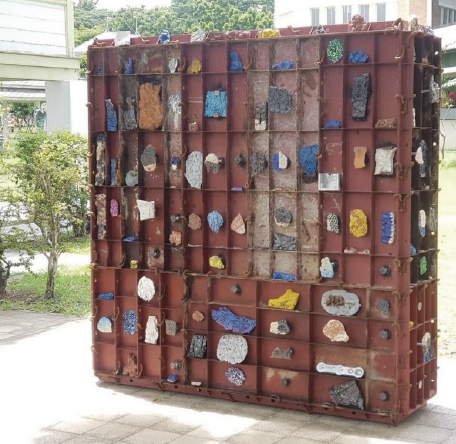CI-VI-LIZE 2024: ร่องรอยอารยธรรมและศิลปะสะท้อนการเปลี่ยนแปลงสังคม-สิ่งแวดล้อม
DOI:
https://doi.org/10.69598/decorativeartsjournal.4.138-161คำสำคัญ:
ศิลปะร่วมสมัย, อารยธรรมยั่งยืน, นิเวศสิ่งแวดล้อม, สัญญะวิทยา, การพัฒนาอย่างยั่งยืนบทคัดย่อ
บทความวิจัยนี้ มีวัตถุประสงค์เพื่อ (1) ศึกษาและค้นคว้า ความสัมพันธ์ระหว่างความยั่งยืนทางนิเวศสิ่งแวดล้อมกับพัฒนาการของอารยธรรมมนุษย์ (2) วิเคราะห์ความหมายเชิงสัญญะและนัยสำคัญของผลงานประติมากรรม CI-VI-LIZE 2024 ในบริบทของความสัมพันธ์ระหว่างการพัฒนาอารยธรรมกับความยั่งยืนของสิ่งแวดล้อม และ (3) แสดงบทบาทของศิลปะร่วมสมัยในการสร้างความตระหนักรู้และกระตุ้นการวิพากษ์เกี่ยวกับประเด็นสิ่งแวดล้อมและความยั่งยืนในสังคมปัจจุบัน วิจัยนี้ใช้ระเบียบวิธีวิจัยเชิงคุณภาพผ่านการวิเคราะห์ตีความเชิงสัญญะ วิเคราะห์ความหมายของสัญลักษณ์ และวัสดุที่ปรากฏในผลงานประติมากรรม CI-VI-LIZE 2024 เพื่อเข้าใจการสื่อความหมายเชิงนัย การทบทวน เอกสารและงานวิจัยที่เกี่ยวข้องกับประเด็นความสัมพันธ์ระหว่างศิลปะ สังคม และสิ่งแวดล้อม รวมถึงแนวคิดเรื่องการพัฒนาอย่างยั่งยืนและบทบาทของศิลปะในการสร้างความเปลี่ยนแปลงทางสังคม การศึกษากรณีเปรียบเทียบผลงาน CI-VI-LIZE 2024 กับงานศิลปะร่วมสมัยอื่น ๆ ที่มีเนื้อหาเกี่ยวข้องกับประเด็นสิ่งแวดล้อมและความยั่งยืน ผลการวิจัยตามวัตถุประสงค์ข้อที่ (1) ความสัมพันธ์ระหว่างความยั่งยืนทางนิเวศสิ่งแวดล้อมกับพัฒนาการของอารยธรรมมนุษย์ โดยอารยธรรมโบราณหลายแห่งล่มสลายเพราะการจัดการทรัพยากรผิดพลาด ขณะที่ยุคอุตสาหกรรมเร่งการทำลายสิ่งแวดล้อม แต่มนุษย์มีศักยภาพปรับตัวผ่านแนวคิดการพัฒนาอย่างยั่งยืน (2) การวิเคราะห์ความหมายเชิงสัญญะและนัยสำคัญของผลงานประติมากรรม CI-VI-LIZE 2024 ตั้งคำถามต่อทิศทางของอารยธรรมผ่านชื่อและวัสดุที่ผสมผสานระหว่างธรรมชาติกับผลผลิตอุตสาหกรรม โครงสร้างคล้ายซากปรักหักพังผสมเทคโนโลยีร่วมสมัยเตือนถึงความเสี่ยงของการล่มสลายหากมนุษย์ละเลยสิ่งแวดล้อม (3) บทบาทของศิลปะร่วมสมัยในการสร้างความตระหนักรู้และกระตุ้นการวิพากษ์เกี่ยวกับประเด็นสิ่งแวดล้อม CI-VI-LIZE 2024 สร้างประสบการณ์เชิงสุนทรียะที่กระตุ้นความตระหนักต่อปัญหาสิ่งแวดล้อม เป็นพื้นที่ถกเถียงประเด็นความยั่งยืน และสร้างเครือข่ายผลักดันการเปลี่ยนแปลงผ่านการผสมผสานมิติประวัติศาสตร์ สังคมวิทยาและนิเวศวิทยา
References
เกษม เพ็ญภินันท์. (2566). ปรัชญาสิ่งแวดล้อมและการพัฒนาที่ยั่งยืน. วารสารสังคมศาสตร์, 45(2), 56-78.
ชัชชม อรรฆภิญญ์. (2567). ความขัดแย้งระหว่างการพัฒนาและการอนุรักษ์ในสังคมไทยร่วมสมัย. วารสารสังคมวิทยามานุษยวิทยา, 43(1), 121-145.
นิธิ เอียวศรีวงศ์. (2565). อารยธรรมและการเสื่อมสลาย : บทเรียนจากประวัติศาสตร์โลก. มติชน.
ประเวศ วะสี. (2565). วิถีสู่ความยั่งยืน: บูรณาการระหว่างเศรษฐกิจ สังคม และสิ่งแวดล้อม. วารสารสังคมศาสตร์และมนุษยศาสตร์, 48(2), 145-168.
พิชัย เกรียงไกรเพชร. (2567). วัสดุศาสตร์กับการพัฒนาอารยธรรมมนุษย์. วารสารวิทยาศาสตร์และเทคโนโลยี, 42(3), 234-258.
วิโรจน์ ศรีวิชัย. (2566). ศิลปะและการวิพากษ์สังคมในยุคโลกร้อน. วารสารศิลปกรรมศาสตร์, 25(2), 78-95.
สมศักดิ์ สมบูรณ์. (2567). ร่องรอยอารยธรรม : การสืบค้นและตีความหลักฐานทางโบราณคดี. จุฬาลงกรณ์มหาวิทยาลัย.
สุธี คุณาวิชยานนท์. (2566). ศิลปะร่วมสมัยกับวิกฤตสิ่งแวดล้อม. วารสารหอศิลป์, 6(1), 45-67.
สุริชัย หวันแก้ว. (2564). มนุษย์กับการเปลี่ยนแปลงทางนิเวศวิทยา. จุฬาลงกรณ์มหาวิทยาลัย.
Baker, J. (2019). Ecology in Mark Dion's art. Journal of Art and Ecology, 7(2), 34-56.
Chang, L. (2024). Material studies in contemporary sculpture: A case study of Wanthorn Waimilier. Journal of Fine and Applied Arts, 26(1), 89-105.
Corrine, P. (2020). Art in the Anthropocene: A conversation with Mark Dion. Journal of Art and Environment, 12(3), 45-67.
Diamond, J. (2019). Collapse: How societies choose to fail or succeed. Matichon Press.
Holling, C. (2020). Resilience and adaptability of social-ecological systems. Journal of Environmental Education, 11(2), 23-45.
Kester, G. (2011). The one and the many: Contemporary collaborative art in a global context. Duke University Press.
Latour, B. (2022). We have never been modern: The separation of nature and culture. Journal of Social Sciences, 41(3), 85-108.
Moore, J. (2022). Capitalism in the Anthropocene: Ecology and capital accumulation. Journal of Political Economy, 10(1), 45-68.
Muniz, V. (2010). The Gypsy Magna-Pictures of Garbage [Photograph]. Waste Land Movie. Retrieved April 20, 2025, from http://www.wastelandmovie.com/gallery.html
Phillips, P. C. (2012). Vik Muniz: Seeing is believing. Art in America, 100(5), 152-159.
Steffen, W., Broadgate, L., & Crutzen, P. (2021). Anthropocene: A conceptual framework for 21st century challenges. Journal of Environmental Science, 15(3), 25-48.
Tainter, J. (2018). The collapse of complex societies: Causes and social impacts. Journal of Social Sciences, 40(2), 112-135.
Waimilier, W. (2022). Art and sustainability: A special interview. Journal of Art and Culture, 18(4), 23-38.
Tanya Bonakdar Gallery. (n.d.). Mark Dion - Cabinet of Marine Debris. Retrieved April 20, 2025, from https://www.tanyabonakdargallery.com/artists/34-mark-dion/works/9650-mark-dion-cabinet-of-marine-debris-2014/
Waste Land Movie. (2013). Gallery-The Gypsy Magna-Pictures of Garbage.

Downloads
เผยแพร่แล้ว
How to Cite
License
Copyright (c) 2025 DEC Journal

This work is licensed under a Creative Commons Attribution-NonCommercial-NoDerivatives 4.0 International License.
จัดทำโดย ฝ่ายวิชาการ คณะมัณฑนศิลป์ มหาวิทยาลัยศิลปากร ลิขสิทธิ์ของบทความเป็นของเจ้าของบทความ บทความที่ได้รับการตีพิมพ์ถือเป็นทรรศนะของผู้เขียน กองบรรณาธิการไม่จำเป็นต้องเห็นด้วยและไม่รับผิดชอบต่อบทความนั้น

